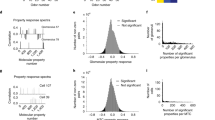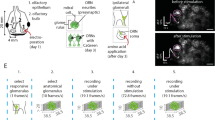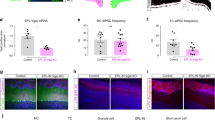Abstract
One defining characteristic of the mammalian brain is its neuronal diversity1. For a given region, substructure, layer or even cell type, variability in neuronal morphology and connectivity persists2,3,4,5. Although it is well known that such cellular properties vary considerably according to neuronal type, the substantial biophysical diversity of neurons of the same morphological class is typically averaged out and ignored. Here we show that the amplitude of hyperpolarization-evoked sag of membrane potential recorded in olfactory bulb mitral cells is an emergent, homotypic property of local networks and sensory information processing. Simultaneous whole-cell recordings from pairs of cells show that the amount of hyperpolarization-evoked sag potential and current (Ih)6 is stereotypic for mitral cells belonging to the same glomerular circuit. This is corroborated by a mosaic, glomerulus-based pattern of expression of the HCN2 (hyperpolarization-activated cyclic nucleotide-gated channel 2) subunit of the Ih channel. Furthermore, inter-glomerular differences in both membrane potential sag and HCN2 protein are diminished when sensory input to glomeruli is genetically and globally altered so that only one type of odorant receptor is universally expressed7. Population diversity in this intrinsic property therefore reflects differential expression between local mitral cell networks processing distinct odour-related information.
This is a preview of subscription content, access via your institution
Access options
Subscribe to this journal
Receive 51 print issues and online access
$199.00 per year
only $3.90 per issue
Buy this article
- Purchase on Springer Link
- Instant access to full article PDF
Prices may be subject to local taxes which are calculated during checkout




Similar content being viewed by others
References
Gupta, A., Wang, Y. & Markram, H. Organizing principles for a diversity of GABAergic interneurons and synapses in the neocortex. Science 287, 273–278 (2000)
Brochtrup, A. & Hummel, T. Olfactory map formation in the Drosophila brain: genetic specificity and neuronal variability. Curr. Opin. Neurobiol. 21, 85–92 (2011)
Reyes, A. et al. Target-cell specific facilitation and depression in neocortical networks. Nature Neurosci. 1, 279–285 (1998)
Jinno, S. et al. Neuronal diversity in GABAergic long-range projections from the hippocampus. J. Neurosci. 27, 8790–8804 (2007)
Brown, S. P. & Hestrin, S. Intracortical circuits of pyramidal neurons reflect their long-range axonal targets. Nature 457, 1133–1136 (2009)
Angelo, K. & Margrie, T. W. Population diversity and function of hyperpolarization-activated current in olfactory bulb mitral cells. Scientific Reports 1, 1:50 (2011)
Fleischmann, A. et al. Mice with a “monoclonal nose”: perturbations in an olfactory map impair odor discrimination. Neuron 60, 1068–1081 (2008)
Tsiola, A., Hamzei-Sichani, F., Peterlin, Z. & Yuste, R. Quantitative morphologic classification of layer 5 neurons from mouse primary visual cortex. J. Comp. Neurol. 461, 415–428 (2003)
Schulz, D. J., Goaillard, J. M. & Marder, E. Variable channel expression in identified single and electrically coupled neurons in different animals. Nature Neurosci. 9, 356–362 (2006)
Ermentrout, G. B., Galan, R. F. & Urban, N. N. Reliability, synchrony and noise. Trends Neurosci. 31, 428–434 (2008)
Marder, E. & Goaillard, J. M. Variability, compensation and homeostasis in neuron and network function. Nature Rev. Neurosci. 7, 563–574 (2006)
Magee, J. C. Dendritic hyperpolarization-activated currents modify the integrative properties of hippocampal CA1 pyramidal neurons. J. Neurosci. 18, 7613–7624 (1998)
Garden, D. L., Dodson, P. D., O'Donnell, C., White, M. D. & Nolan, M. F. Tuning of synaptic integration in the medial entorhinal cortex to the organization of grid cell firing fields. Neuron 60, 875–889 (2008)
George, M. S., Abbott, L. F. & Siegelbaum, S. A. HCN hyperpolarization-activated cation channels inhibit EPSPs by interactions with M-type K+ channels. Nature Neurosci. 12, 577–584 (2009)
Nolan, M. F., Dudman, J. T., Dodson, P. D. & Santoro, B. HCN1 channels control resting and active integrative properties of stellate cells from layer II of the entorhinal cortex. J. Neurosci. 27, 12440–12451 (2007)
Lüthi, A. & McCormick, D. A. Periodicity of thalamic synchronized oscillations: the role of Ca2+-mediated upregulation of Ih . Neuron 20, 553–563 (1998)
Giocomo, L. M., Zilli, E. A., Fransen, E. & Hasselmo, M. E. Temporal frequency of subthreshold oscillations scales with entorhinal grid cell field spacing. Science 315, 1719–1722 (2007)
Migliore, M. & Shepherd, G. M. Emerging rules for the distributions of active dendritic conductances. Nature Rev. Neurosci. 3, 362–370 (2002)
Woolsey, T. A. & Van der Loos, H. The structural organization of layer IV in the somatosensory region (SI) of mouse cerebral cortex. The description of a cortical field composed of discrete cytoarchitectonic units. Brain Res. 17, 205–242 (1970)
Mombaerts, P. Targeting olfaction. Curr. Opin. Neurobiol. 6, 481–486 (1996)
Schoppa, N. E. & Westbrook, G. L. Glomerulus-specific synchronization of mitral cells in the olfactory bulb. Neuron 31, 639–651 (2001)
Pimentel, D. O. & Margrie, T. W. Glutamatergic transmission and plasticity between olfactory bulb mitral cells. J. Physiol. 586, 2107–2119 (2008)
Robinson, R. B. & Siegelbaum, S. A. Hyperpolarization-activated cation currents: from molecules to physiological function. Annu. Rev. Physiol. 65, 453–480 (2003)
Notomi, T. & Shigemoto, R. Immunohistochemical localization of Ih channel subunits, HCN1–4, in the rat brain. J. Comp. Neurol. 471, 241–276 (2004)
Santoro, B. et al. Molecular and functional heterogeneity of hyperpolarization-activated pacemaker channels in the mouse CNS. J. Neurosci. 20, 5264–5275 (2000)
Cadetti, L. & Belluzzi, O. Hyperpolarisation-activated current in glomerular cells of the rat olfactory bulb. Neuroreport 12, 3117–3120 (2001)
van Welie, I., van Hooft, J. A. & Wadman, W. J. Homeostatic scaling of neuronal excitability by synaptic modulation of somatic hyperpolarization-activated Ih channels. Proc. Natl Acad. Sci. USA 101, 5123–5128 (2004)
Desai, N. S., Rutherford, L. C. & Turrigiano, G. G. Plasticity in the intrinsic excitability of cortical pyramidal neurons. Nature Neurosci. 2, 515–520 (1999)
Padmanabhan, K. & Urban, N. N. Intrinsic biophysical diversity decorrelates neuronal firing while increasing information content. Nature Neurosci. 13, 1276–1282 (2010)
Dhawale, A. K., Hagiwara, A., Bhalla, U. S., Murthy, V. N. & Albeanu, D. F. Non-redundant odor coding by sister mitral cells revealed by light addressable glomeruli in the mouse. Nature Neurosci. 13, 1404–1412 (2010)
Acknowledgements
We thank M. Velez-Fort for comments on the manuscript. E.A.R. is a recipient of a Sir Henry Wellcome Fellowship. This project was supported by the Oticon Foundation, the Danish Council for Independent Research and the Lundbeckfondation (K.A.), the Gulbenkian PhD Programme and Fundação para a Ciência e Tecnologia (D.P.), The Wellcome Trust (T.W.M.) and Medical Research Council MC_U1175975156 (B.P. and T.W.M.).
Author information
Authors and Affiliations
Contributions
K.A. and E.A.R. performed electrophysiological experiments. C.H. and J.H. carried out immunohistochemistry. D.P. performed morphological reconstructions and some initial electrophysiological experiments. B.P. and E.A.R. contributed to data analysis. A.F. generated the transgenic mouse line. K.A. and T.W.M. conceived the project and performed analysis. T.W.M. wrote the paper with input from all other authors.
Corresponding author
Ethics declarations
Competing interests
The authors declare no competing financial interests.
Supplementary information
Supplementary Information
This file contains Supplementary Figures 1-3, Supplementary Methods and additional references. (PDF 3522 kb)
Rights and permissions
About this article
Cite this article
Angelo, K., Rancz, E., Pimentel, D. et al. A biophysical signature of network affiliation and sensory processing in mitral cells. Nature 488, 375–378 (2012). https://doi.org/10.1038/nature11291
Received:
Accepted:
Published:
Issue Date:
DOI: https://doi.org/10.1038/nature11291
This article is cited by
-
Heterogeneity of voltage gated sodium current density between neurons decorrelates spiking and suppresses network synchronization in Scn1b null mouse models
Scientific Reports (2023)
-
A biophysical and statistical modeling paradigm for connecting neural physiology and function
Journal of Computational Neuroscience (2023)
-
Stimulus dependent diversity and stereotypy in the output of an olfactory functional unit
Nature Communications (2018)
-
Olfactory cortical neurons read out a relative time code in the olfactory bulb
Nature Neuroscience (2013)
-
Mapping brain circuitry with a light microscope
Nature Methods (2013)
Comments
By submitting a comment you agree to abide by our Terms and Community Guidelines. If you find something abusive or that does not comply with our terms or guidelines please flag it as inappropriate.



